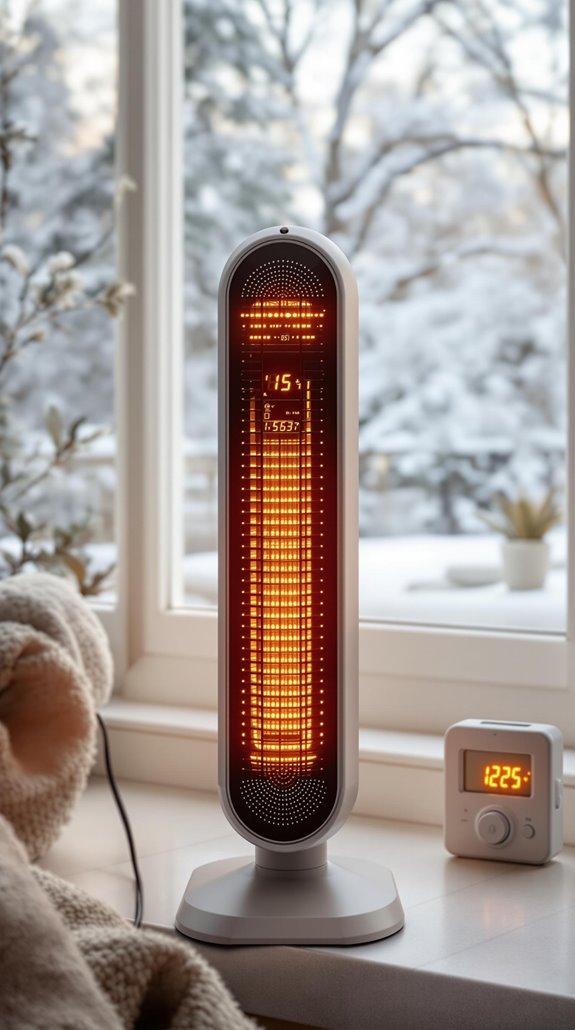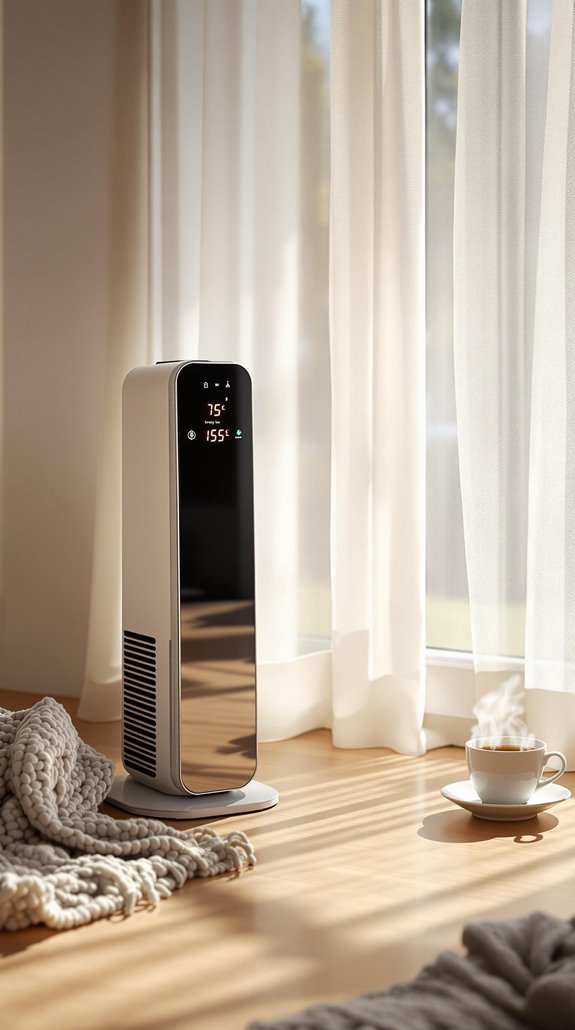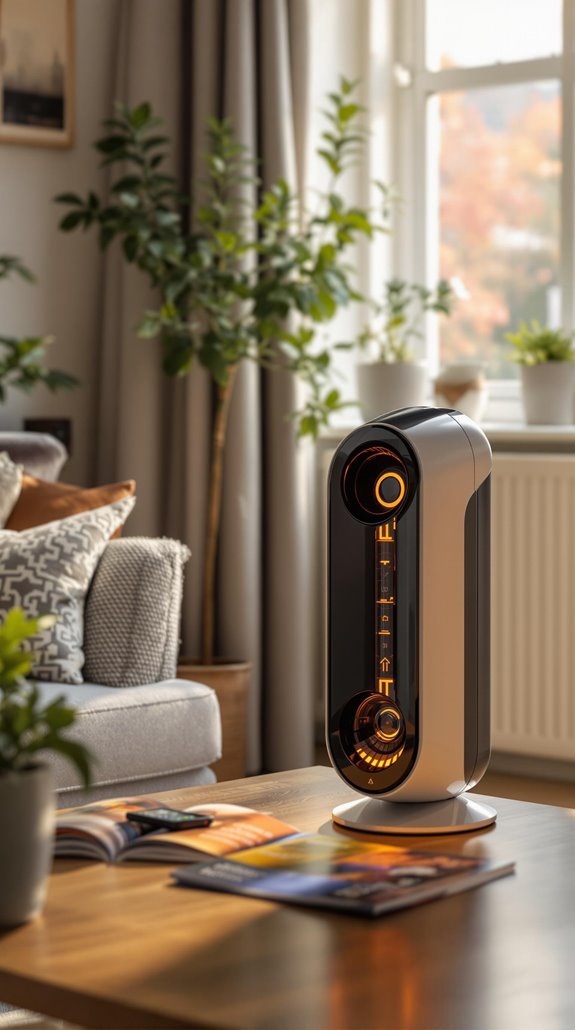I’ve been tracking fan heater running costs across the UK, and what I’ve discovered will likely surprise you. With electricity rates hitting new peaks in 2025, that convenient portable heater you’re relying on could be costing you nearly £90 monthly if you’re running it eight hours daily. Before you panic about your winter bills, though, there’s a strategic approach to slash these expenses by up to 60% – and it doesn’t require freezing through the cold months.
Key Takeaways
- A 1.5kW fan heater costs 37.3p per hour, totaling £44.70 monthly for four hours daily use.
- Fan heaters are among the most expensive heating methods; oil heaters cost half as much.
- Set thermostats to 18-20°C and use ECO modes to reduce energy consumption by up to 35%.
- Heat only occupied rooms with portable units and use timer scheduling during peak occupancy hours.
- Government schemes like ECO4 and Boiler Upgrade offer funding for efficient heating system upgrades.
Understanding UK Electricity Rates in 2025

Before calculating your fan heater’s running costs, you’ll need to understand how UK electricity pricing works in 2025. Ofgem’s current price cap sets electricity at 25.73p per kWh, plus a 51.37p daily standing charge. This represents a welcome decrease from the previous quarter’s 27.03p per kWh rate.
Your electricity bill comprises two elements: the variable cost (based on usage) and the fixed daily standing charge (regardless of consumption). Ofgem adjusts these rates quarterly, reflecting wholesale energy prices and network costs. If you’re on a prepayment meter, you’ll pay the same standing charges as direct debit customers, though standard credit customers typically pay around 10% more for standing charges.
The good news is we’re seeing downward pressure on rates. Compared to April-June 2025, you’re saving 1.3p per kWh. For fan heater calculations, you’ll primarily focus on the variable rate since heating appliances greatly impact your usage-based charges.
Daily and Monthly Operating Expenses for Fan Heaters
When calculating your fan heater’s actual costs, you’ll find that a typical 1.5kW model consumes electricity at 37.3p per hour based on the current 24.86p per kWh rate. If you’re running it for four hours daily, you’re looking at £1.49 per day, totaling £10.43 weekly.
Monthly expenses vary dramatically based on usage patterns. Four hours daily costs £44.70 monthly, while eight hours doubles that to £89.40. Running it constantly hits £268.40—that’s nearly thirty times your fridge freezer’s monthly cost.
I’ve found strategic timing essential for controlling costs. You can’t treat fan heaters like central heating without serious bill shock. Modern electric wall heaters include built-in thermal overheating protection for enhanced safety during extended use. Higher-wattage 2kW models cost 49.7p hourly, making annual costs reach £536.40 for moderate daily use.
How Fan Heaters Compare Against Other Heating Options

While fan heaters deliver instant warmth, they’re among the most expensive heating options you’ll encounter. I’ve found oil heaters cost half as much to run as fan heaters, making them a smarter choice for prolonged use. Oil heaters also retain heat longer and produce less dried-out air, creating better comfort levels. In 2025, the UK housing market has shown a growing trend towards energy-efficient solutions, encouraging homeowners to consider more sustainable heating options.
Heat pumps offer the lowest running costs due to their high efficiency, though they require higher upfront investment. For UK homes, gas central heating remains dominant and most cost-effective for whole-house heating. However, if you’re heating individual rooms selectively, electric heaters like oil-filled radiators help avoid wasting energy on unused spaces.
Your best strategy depends on your specific situation—fan heaters work for quick warming, but alternatives save money long-term. Heat pumps also provide versatile systems that can switch between heating and cooling throughout the year.
Strategic Usage Tips to Minimize Running Costs
Since fan heaters consume electricity at rates of 37.3p per hour for a 1.5kW model, I’ve discovered that strategic usage patterns can slash your running costs by 60% or more.
I focus on heating only occupied rooms, moving my portable unit where I’m actually spending time. Closing doors traps warmth efficiently, maximizing each penny spent. Additionally, effective draft-proofing front doors can enhance insulation, further reducing the need for heating. I set thermostats to 18-20°C rather than cranking them higher—contrary to popular belief, higher settings don’t heat rooms faster, they just run longer.
Timer scheduling transforms costs dramatically. I program 2-hour bursts during peak occupancy rather than continuous operation. This targeted approach works brilliantly for smaller spaces where fan heaters excel. I’ve learned they’re not just emergency backup—when used strategically in the right-sized rooms, they become genuine money-savers. Areas cool quickly after switching off, so timing becomes crucial for maintaining comfort while controlling expenses.
Energy Efficiency Features That Reduce Bills

Modern fan heaters pack several energy-saving features that’ll cut your electricity bills without sacrificing warmth. I’ve found ECO modes deliver the biggest savings—they automatically optimize power usage and can reduce consumption by up to 35% compared to standard models. Additionally, heating costs can vary significantly based on factors such as home size and insulation quality, making efficient heating even more crucial. Adjustable heat settings let you dial in exactly what you need, preventing energy waste from overheating rooms.
The latest heating technology maximizes output per unit of electricity, while smart thermostats maintain your desired temperature without constant cycling. Portability becomes a money-saver when you heat only occupied rooms instead of your entire home. For added versatility, many models now include cool air functions that extend their usefulness into warmer months.
Timer functions guarantee you’re not heating empty spaces, and programmable controls adapt to your schedule. These features work together, transforming fan heaters from energy guzzlers into efficient heating solutions that respect both your comfort and wallet.
Environmental Benefits of Smart Heater Usage
Smart heater usage delivers measurable environmental benefits that extend far beyond your monthly energy bill. I’ve found that modern smart heaters reduce carbon emissions by up to 20% through precise temperature control and occupancy-based adjustments. These systems prevent energy waste by automatically shutting off when rooms are unoccupied and learning your daily routines.
What’s particularly impressive is how smart heaters support the UK’s net zero targets. They’re designed to work seamlessly with our increasingly renewable energy grid, using power when solar and wind generation peaks. This compatibility means you’re contributing to national decarbonization efforts while cutting costs. With home heating accounting for approximately 20% of UK carbon emissions, every smart heating choice makes a meaningful difference in our collective environmental impact. The principles of Passivhaus design can further enhance the efficiency of these systems by emphasizing superior insulation and air-tightness.
The cumulative impact matters—when we collectively adopt smart heating technology, we’re helping reduce the built environment’s 30% share of UK greenhouse gas emissions while protecting our wallets.
Government Grants and Financial Support Available

While smart heaters offer impressive environmental benefits, you shouldn’t overlook the substantial government grants available to reduce your upfront heating costs. I’ve found the ECO4 Scheme particularly valuable for households receiving Universal Credit—it provides fully funded central heating systems if you’re currently without one and your property has an EPC rating D-G. Proper insulation is essential for maximizing the efficiency of your home’s thermal efficiency, which can further enhance the benefits of these heating upgrades.
The Boiler Upgrade Scheme offers £7,500 toward heat pumps until December 2027, though you’ll need an EPC rating A-D. For off-gas properties, HUG 2 targets households earning under £31,000 annually with £630 million allocated for low-carbon heating upgrades. These grants eliminate financial barriers for households by covering installation costs completely.
Most schemes require no upfront costs and process applications within 4-8 weeks. You’ll typically save £300-£600 annually on energy bills post-upgrade.
Solar Power Integration for Lower Heating Costs
Beyond government funding, you’ll achieve the most dramatic reductions in heating costs by pairing solar power with energy-efficient heaters. I recommend combining a minimum 3.5kW solar PV system with far-infrared heaters, which consume 30-50% less energy than conventional fan heaters at just 500-1000W versus 2000W+.
You’ll eliminate 70-100% of heating electricity costs seasonally while earning £85-£110 annually per kW through the Smart Export Guarantee. Wi-fi-enabled electric radiators let you prioritise solar energy during peak generation hours, maximising your self-consumption. Understanding loan terms can also help you make informed decisions about financing your energy-efficient upgrades.
Battery storage systems retain excess solar power for evening heating, while integrated PV-thermal systems capture 100% of incident sunlight. Professional energy audits determine ideal sizing, with installation costs typically recovered within 5-8 years through combined savings and export payments. FIR systems deliver nearly 100% efficiency by converting almost all consumed electricity directly into heat output.
Budget Planning for Winter Heating Expenses
Given the confirmed price cap increase to £1,849 annually from April 2025, I’ll show you how to build a realistic winter heating budget that accounts for quarterly volatility and maximizes available support schemes.
I recommend allocating £150 monthly for heating during winter months, using the April baseline for calculations. Track price cap announcements in February and August—they’re your budget recalibration points. With 8.99 million UK households now spending over 10% of income on energy, we’re all feeling this squeeze together.
Check your eligibility for the expanded Warm Home Discount covering 3 million additional households, and Child Winter Heating Payments worth £251.50. The cumulative £132 increase since October 2024 means quarterly budget reviews aren’t optional—they’re essential for avoiding nasty surprises. Just as solar activity influences long-term climate patterns, energy price fluctuations follow predictable cycles that savvy budgeters can anticipate and plan around.
Future-Proofing Against Rising Energy Prices
As energy prices continue their upward trajectory with the current price cap at £1,720 annually and forecasts showing minimal relief ahead, you’ll need concrete strategies to shield your household from mounting costs.
I recommend starting with energy efficiency upgrades that deliver measurable returns. Proper insulation and draught-proofing can reduce heating demands by 15-25%, directly cutting your fan heater usage. Smart thermostats and programmable timers prevent wasteful heating cycles. Additionally, investing in energy-efficient appliances can further decrease overall energy consumption.
Consider renewable energy installations like solar panels or heat pumps, which provide long-term protection against volatile wholesale prices that jumped 34% in early 2024. These investments offer energy independence when geopolitical tensions spike costs. The energy market remains particularly vulnerable to global events that can trigger sudden price shocks.
Monitor quarterly price cap updates to anticipate billing changes and adjust your budget accordingly. Building energy resilience now protects you from future market volatility.
Conclusion
I’ve shown you fan heaters cost £89 monthly at eight hours daily, but you can slash these bills through strategic usage. Set your thermostat to 18-20°C, heat only occupied rooms, and consider oil heaters or heat pumps for better efficiency. Don’t overlook government grants and solar integration opportunities. Plan your winter budget now and implement these cost-saving measures—your energy bills will reflect the difference immediately.
References
- https://www.morrisdirect.co.uk/blogs/advice-centre-tubular-heaters/how-much-does-it-cost-to-run-energy-efficient-electric-heaters-wall-mounted
- https://iea.blob.core.windows.net/assets/28f84ed8-4101-4e95-ae51-9536b6436f14/Multiple_Benefits_of_Energy_Efficiency-148×199.pdf
- https://uk.jackery.com/blogs/home-backup/are-electric-heaters-expensive-to-run
- https://www.adb.org/sites/default/files/publication/479891/handbook-battery-energy-storage-system.pdf
- https://www.sust-it.net/heating-energy-calculator.php
- https://www.nimblefins.co.uk/average-cost-electricity-kwh-uk
- https://www.doreebonner.co.uk/understanding-the-surge-in-uk-energy-bills/
- https://www.ofgem.gov.uk/news/changes-energy-price-cap-between-1-april-and-30-june-2025
- https://www.at-eco.co.uk/blog/uk-energy-costs-2025.html
- https://www.uswitch.com/gas-electricity/guides/regional-energy-prices/

